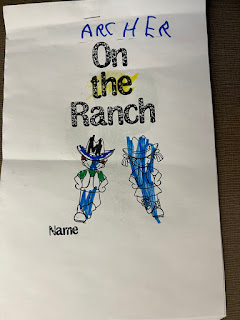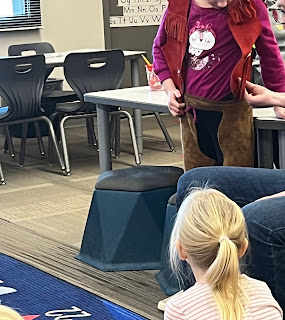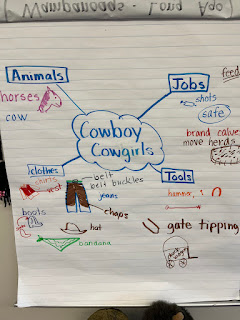Cowboys & Cowgirls: Building Knowledge
Our Kindergarten class is studying cowboys and cowgirls from the past. The standard achieved through these lessons are from CAS Social Studies History 1.2- Understand that the sequence of events is important when describing the past. We also have been integrated writing and communication standards into our study to solidify learning through labeling and art-related craft projects.
Within Kindergarten, Social Studies lessons are integrated throughout the day as a way to slowly build background knowledge. My mentor teacher used many strategies to create inquiry to help familiarize and build student vocabulary. She implemented Dimension 1 of the Inquiry Arc (CLAS Network. (2015. Augst 28) by creating Compelling and Supporting questions during group discussions and guided the students through Dimension 2 as they applied their learning during art and writing related projects.
Strategies to Build Knowledge:
1. Engage through Inquiry with Compelling & Supporting Questions
Group discussion: At the top of the week, the teacher engaged the students in a group discussion and asked what they knew about cowboys and cowgirls. Kopp states the C3 Framework of inquiry begins with asking questions (Kopp, 2017, p. 17). Seeing this engagement first-hand not only confirmed how these converstations sparked interest in the students, but how it gave the teacher an opportunity to collect data on students knowledge. The students really enjoyed sharing what they knew and asked many questions!
Teacher: What do you know about cowboys or cowgirls? Can both girls and boys be cowboys? Raise your hand to share.
Students: I know that cowboys ride horses. Are cowboys real? I know cowboys chase bulls!
2. Picture Books and Stories
The teacher took advantage of snack time to build knowledge and vocabulary of cowpoke by reading picture story books. As she read, she asked comprehension questions about cowboy jobs and asked the children to identify clothing. What is this on her head? What is special about their boots? Why are they doing around the campfire?
Children love to be read to and without realizing, they were learning as well. I heard students begin to identify cowpoke clothing, jobs, and the animals they work with as they listened to the stories.
3. Art-Related Activities:
Kopp said making connections to the content through hands-on activites or art-related projects improves understanding of the content (Kopp, 2017, p. 18). To further connection and undstanding, the students created a cowboy or cowgirl landscape art project where they drew boots, vest, pants, shirt, bandana and a hat. Our visually impaired student used wax string to define each part of the picture and colored in the boundaries with crayon. The student with an IEP for Autism was given more time to complete the project. The students made personal connections to their learning as they enjoyed creating their own shirts, bandanas, hair, and boots. This activity also covered a Writing and Communication standard of writing a narrative through the use of dictation or drawing. As the students created, we heard tell tell their tablemates what their cowboy or cowgirl were doing or seeing in the picture.
4. Related Reading and Writing Activity:
As another way to connect content to learning, the students built vocabulary by reading and coloring a picture book titled 'On the Ranch'. This book is a good differentiation tool for our variety of readers. Students who read at higher levels were able to read each page and grow their understanding, while those who read at grade level or below were able to build knowledge through the pictures on each page.
Kopp said 'scaffolding is the action you take to support students' (Kopp, 2017, p.23). When I reflect on this idea and this simple picture book, I see how it allowed all the students to be and feel successful. For the teachers in the room, we were able to use this book and engage with students in different ways. For example, some kids read the book to me while others pointed to the pictures and told me what they saw and knew what color to use. Everyone connected to the content and was successful.

The students then decorated a cowboy boot of their own and then integrated their art and writing skills to describe its features. My boot has a heart and swirls.
5. Hands-on Experience:
To further solidify learning, the teacher engaged the students with a hands-on lesson. She brought in cowboy clothing and demonstrated how each item is worn and why. The Kindergartners absolutely loved this lesson! They were extremely engaged and enjoyed watching one of their classmates being dressed up. Our visually impaired student also engaged in this lesson by feeling and holding the clothes.
By the end of the week, the students were able to identify and name cowpoke clothing. The teacher began creating a Word Web (Kopp, 2017, p. 36) as a visual organizer to capture learned knowledge. With Cowboy/Cowgirl at the center, teacher and students began creating categories such as clothing, jobs, and food around the web. Since we have varying levels of readers, the teacher drew pictures next to the words so everyone could access the web later. Since we are working with Kindergarteners, the teacher did nudge to help the students to build the categories. 'The (word) webs should remain posted througout the unit so that students can revist the words...'(Kopp, 2017, p. 37). We have kept this poster up throughout the week and I have seen the benefits in doing so as many students have referenced it to spell cowboy words.
6. Technology:
Since cowboyw have changed over the years, we watched a video about real kid-cowboys. Cowboy Kids. The students really enjoyed seeing real cowboys as they explained how their clothing helps them do their work and how their horses help them get around the ranch. This video certainly led to more supporting questions and discussion. Are cowboys real?
This video was another great strategy for building knowledge-especially for verbal-linguistic learners. Kopp reminded us that teaching to the varying learning styles and intelligences a useful teaching strategy (Kopp, 2017, p. 21). This is a strategy I hope to remember as I see how learning preferences and intelligences affect learning.
Students also had opportunities to use Epic, a digital library used at school, to access books about cowboys.
7. Strategies used but not pictured:
- Cowboy/cowgirl picture books available around the classroom for students to read
- Epic books on Cowboys
Conclusion
Overall, I believe the teacher did an excellent job using a variety of strategies to teach this lesson and create inquiry about cowboys. She differentiated and used scaffold lessons to ensure understanding. The students enjoyed learning about cowboy clothes and applying their knowledge through art, writing, and discussion.
I would be curious to know if the KWL chart- a strategy to visually show 'what the students know, want to know, and learned' would work in Kindergarten as many of the students are still learning to read. However, I do like how this teaching strategy can build discussions and inquiry over new material. I plan to ask my mentor teacher her thoughts on this theory and if she ever uses it.
*We were unable to teach a science lesson this week as we were off for MLK Jr and had an extra late start in addition to our weekly late start.
References
Colorado academic standards online. (n.d.). https://www.cde.state.co.us/apps/standards/
CLAS Network. (2015, August 28). How to write Student-Friendly Learning Objectives [Video]. YouTube. https://www.youtube.com/watch?v=67VaF84_VWs
Kopp, K. (2017) Teaching Social Studies today, 2nd Edition (Shell Education).























I love Social Studies in kindergarten! There are so many engaging activities that you can tie into a topic and the kids are like little sponges, soaking it all in! I really appreciated your comment about using the "On the Ranch" workbook for differentiation. Incorporating pictures and colors helped struggling readers feel successful recounting the book, while those ready for some extension could read all the words. I love when one tool can be a great scaffold for all the levels of your students!
ReplyDeleteI also love the thinking map on cowboys- what a great tool for students to reference when they are writing and doing other activities. I love that it has pictures and words so that students can feel confident using it independently.
What a fun week in kindergarten, thanks for sharing!
Jess-thank you. I am really beginning to notice the subtleties of how the teacher makes learning available to all her students. Regarding the word wall, I'm sure for many teachers such strategies just come naturally, but its been neat to see theory in practice. Thanks for the note!
DeleteAnna,
ReplyDeleteIt sounds like such a fun and engaging way to introduce young learners to history! I love how the teacher incorporated multiple strategies- picture books, hands-on experiences, technology, and art- to make the cowpoke unit accessible to all students. The inclusion of tactile elements for the visually impaired student and extended time for the students with autism shows great attention to differentiation and ensuring all students can participate meaningfully.
The Word Web strategy seems like a great visual tool for reinforcing vocabulary and concepts throughout the unit. Have you noticed students referring back to it independently as they work on activities or share their thoughts? I'd love to hear if it's been an effective ongoing resource for them!